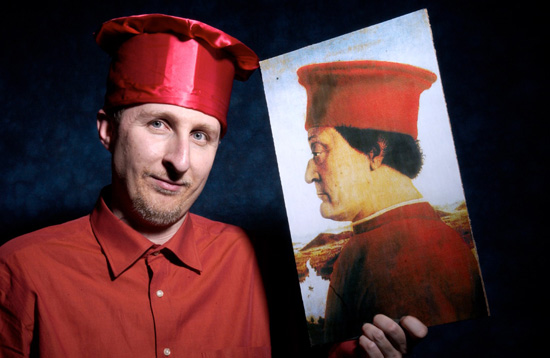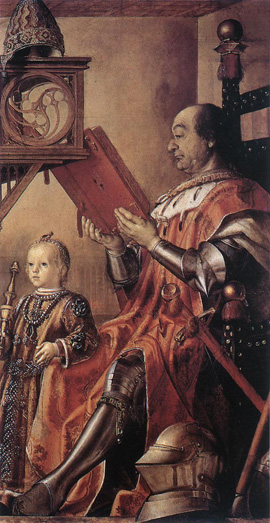Medieval Studies Faculty Curates Exhibit on Italian Renaissance Man
 |
| Marcello Simonetta, assistant professor of medieval studies, romance languages and literatures, is the curator of a recent exhibit Federico da Montefeltro and His Library, in New York through September. Pictured in Simonetta’s hand, and below, are portraits of the Italian Duke da Montefeltro. |
| Posted 07/11/ 07 |
 In 1475, the fully-armored Italian Duke of Urbino posed for a self-portrait in the ductal library with his son at his side. This famous oil painting, pictured at right, containing a 500-year-old mystery, is the centerpiece of a current exhibit, curated by Marcello Simonetta, assistant professor of medieval studies, romance languages and literatures. In 1475, the fully-armored Italian Duke of Urbino posed for a self-portrait in the ductal library with his son at his side. This famous oil painting, pictured at right, containing a 500-year-old mystery, is the centerpiece of a current exhibit, curated by Marcello Simonetta, assistant professor of medieval studies, romance languages and literatures.
Titled, Federico da Montefeltro and His Library, the show is on display through Sept. 30 at the Morgan Library & Museum in New York, N.Y. Simonetta has studied Duke da Montefeltro since writing his Ph.D. dissertation at Yale. I have always been fascinated by this great patron of the arts, who was also a successful mercenary captain, Simonetta explains. The combination of refined taste and ruthless politics is what makes him a sort of archetype of the Italian Renaissance man. In 1444 at the age of 22, Da Montefeltro, the illegitimate son of the count of Urbino, was able to inherit his fathers title. He made his reputation as a condottiere, or hired commander, and invested a lot of his money in building a fairy-tale palazzo in Urbino. Its crowning glory was the richest manuscript library of the Renaissance. His books highlight his intellectual curiosity on theology, geography, poetry, history and astrology. He became duke of Urbino in 1474, and died in 1482. The show includes an imposing eagle-shaped lectern from the Museo Diocesano Albani in Urbino; a group of illuminated manuscripts from the Vatican Library; one horoscope from Yale University; and one of the dukes printed books from Bryn Mawr. But it is the painting, perhaps by Justus van Ghent or Pedro Berruguete (scholars cannot agree on the source), that stands out in the exhibit. For more than 500-years, historians have questioned what manuscript the duke is holding in the portrait. Simonetta recently solved the mystery, saying it is Pope Gregory the Greats interpretation of Moralia in Job. This text contained more than a half million words explaining the Book of Job. It is a very influential theological work, and it fits perfectly the Dukes self-fashioning mania as a man of action who also poses as a champion of the humanities, Simonetta says. The revealing clues for Simonetta were the features of the original binding and the size of the manuscript. Because bindings were unique to each book in those days, Simonetta was able to do some academic detective work to confirm his suspicions. In addition to curating the exhibit, Simonetta is the co-author of the exhibits 195-page hardcover catalog. The catalogue is lavishly illustrated, containing some of the best images from the Montefeltro Library. There are essays and entries from other scholars, namely Delio Proverbio, who discovered that half of Federicos Hebrew manuscripts were looted in 1472 from the private library of a Jewish merchant, and Martin Davies, who proved that Federico owned at least 50 printed books. In 2005, Simonetta proposed the exhibit idea to Morgan Library Director Charlie Pierce. Once approved, Simonetta sought funds through the Foundation for Italian Art and Culture. He managed to borrow all the pieces needed for the exhibit. Simonetta, a native of Rome, began teaching at Wesleyan in 2001. He will direct the Eastern College Consortium (for Wesleyan, Vassar College and Wellesley College) from Bologna, Italy in 2007-08. Simonettas next book, The Montefeltro Conspiracy. A Renaissance Mystery Decoded, will be published by Doubleday in 2008. It narrates the thrilling story of the attempted killing of Lorenzo the Magnificent and, in a series of twists, it ends up in the Sistine Chapel, revealing some hittherto unknown coded meanings of Botticellis and Michelangelos frescoes. The Morgan Library is located at 225 Madison Avenue in New York. The exhibition will take place in the Morgan’s new Clare Eddy Thaw Gallery, a perfect Renaissance cube designed by Renzo Piano. The walls will be covered with digital reproductions of the ducal studiolo, with its inlaid wood panels and portraits of popes, philosophers and poets. For more information go to: http://www.morganlibrary.org/exhibitions/federico.asp. |
| By Olivia Drake, The Wesleyan Connection editor. Photo by Bill Burkhart, university photographer. |

